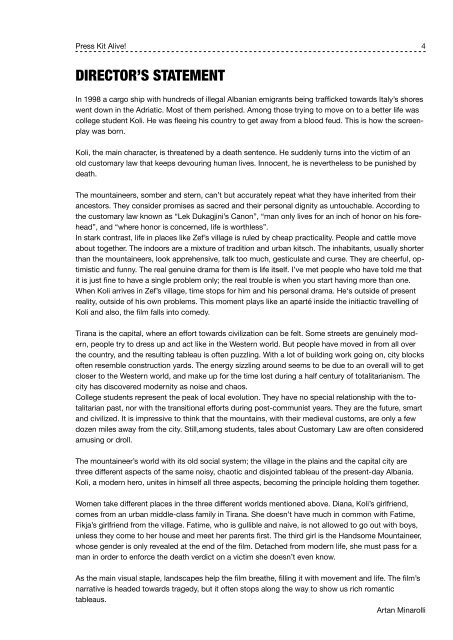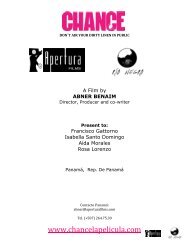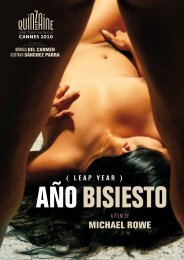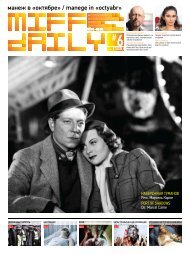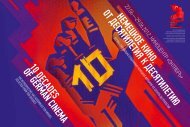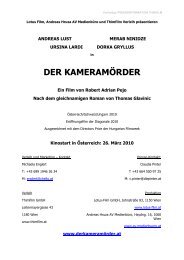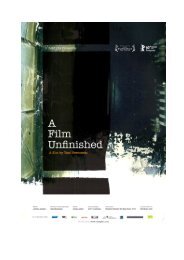PRESS KIT
PRESS KIT
PRESS KIT
Create successful ePaper yourself
Turn your PDF publications into a flip-book with our unique Google optimized e-Paper software.
Press Kit Alive! 4<br />
DIRECTOR’S STATEMENT<br />
In 1998 a cargo ship with hundreds of illegal Albanian emigrants being trafficked towards Italy’s shores<br />
went down in the Adriatic. Most of them perished. Among those trying to move on to a better life was<br />
college student Koli. He was fleeing his country to get away from a blood feud. This is how the screenplay<br />
was born.<br />
Koli, the main character, is threatened by a death sentence. He suddenly turns into the victim of an<br />
old customary law that keeps devouring human lives. Innocent, he is nevertheless to be punished by<br />
death.<br />
The mountaineers, somber and stern, can’t but accurately repeat what they have inherited from their<br />
ancestors. They consider promises as sacred and their personal dignity as untouchable. According to<br />
the customary law known as “Lek Dukagjini’s Canon”, “man only lives for an inch of honor on his forehead”,<br />
and “where honor is concerned, life is worthless”.<br />
In stark contrast, life in places like Zef’s village is ruled by cheap practicality. People and cattle move<br />
about together. The indoors are a mixture of tradition and urban kitsch. The inhabitants, usually shorter<br />
than the mountaineers, look apprehensive, talk too much, gesticulate and curse. They are cheerful, optimistic<br />
and funny. The real genuine drama for them is life itself. I’ve met people who have told me that<br />
it is just fine to have a single problem only; the real trouble is when you start having more than one.<br />
When Koli arrives in Zef’s village, time stops for him and his personal drama. He‘s outside of present<br />
reality, outside of his own problems. This moment plays like an aparté inside the initiactic travelling of<br />
Koli and also, the film falls into comedy.<br />
Tirana is the capital, where an effort towards civilization can be felt. Some streets are genuinely modern,<br />
people try to dress up and act like in the Western world. But people have moved in from all over<br />
the country, and the resulting tableau is often puzzling. With a lot of building work going on, city blocks<br />
often resemble construction yards. The energy sizzling around seems to be due to an overall will to get<br />
closer to the Western world, and make up for the time lost during a half century of totalitarianism. The<br />
city has discovered modernity as noise and chaos.<br />
College students represent the peak of local evolution. They have no special relationship with the totalitarian<br />
past, nor with the transitional efforts during post-communist years. They are the future, smart<br />
and civilized. It is impressive to think that the mountains, with their medieval customs, are only a few<br />
dozen miles away from the city. Still,among students, tales about Customary Law are often considered<br />
amusing or droll.<br />
The mountaineer’s world with its old social system; the village in the plains and the capital city are<br />
three different aspects of the same noisy, chaotic and disjointed tableau of the present-day Albania.<br />
Koli, a modern hero, unites in himself all three aspects, becoming the principle holding them together.<br />
Women take different places in the three different worlds mentioned above. Diana, Koli’s girlfriend,<br />
comes from an urban middle-class family in Tirana. She doesn’t have much in common with Fatime,<br />
Fikja’s girlfriend from the village. Fatime, who is gullible and naive, is not allowed to go out with boys,<br />
unless they come to her house and meet her parents first. The third girl is the Handsome Mountaineer,<br />
whose gender is only revealed at the end of the film. Detached from modern life, she must pass for a<br />
man in order to enforce the death verdict on a victim she doesn’t even know.<br />
As the main visual staple, landscapes help the film breathe, filling it with movement and life. The film’s<br />
narrative is headed towards tragedy, but it often stops along the way to show us rich romantic<br />
tableaus.<br />
Artan Minarolli


